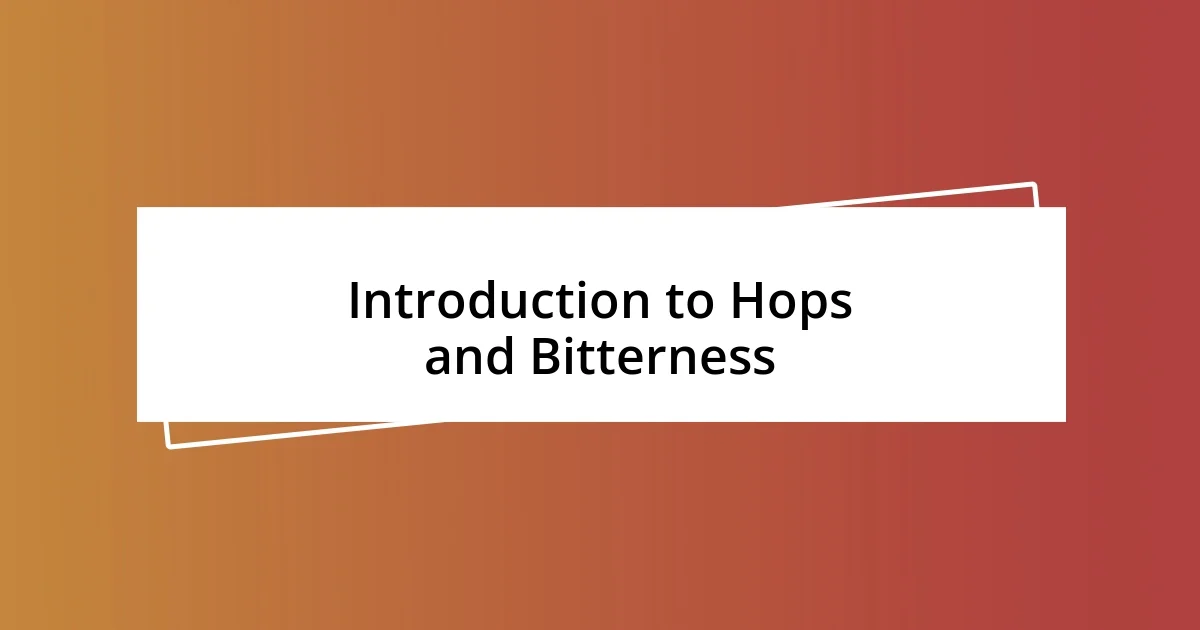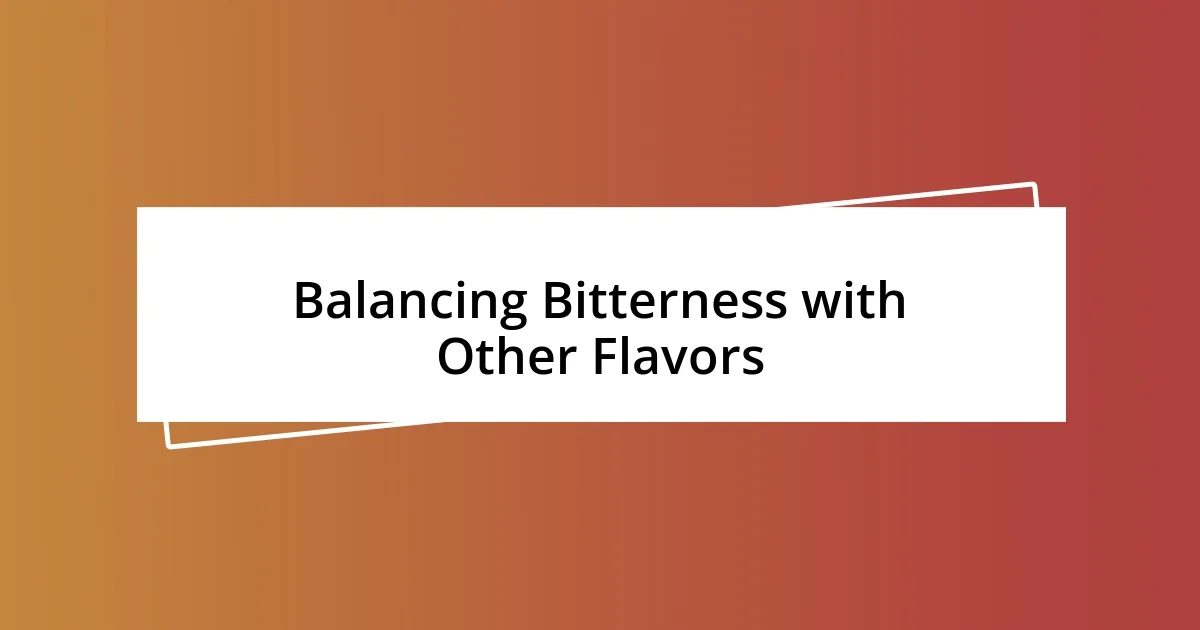Key takeaways:
- Hops not only add bitterness to beer but also contribute diverse aromas and flavors, enhancing the overall brewing experience.
- Understanding and exploring different hop flavor profiles, such as citrus, piney, and floral notes, can significantly elevate beer appreciation.
- Bitterness is measured in International Bitterness Units (IBUs), but balanced flavors can make the perception of bitterness feel softer and more harmonious in various beer styles.

Introduction to Hops and Bitterness
Hops are fascinating little green flowers that play a crucial role in brewing. They not only add bitterness to balance the sweetness of malt but also contribute complex aromas and flavors that can transform a simple beer into an unforgettable experience. Have you ever noticed how a well-hopped IPA can evoke feelings of fresh pine or citrus? That’s the magic of hops at work.
I remember the first time I tasted a double IPA. As I sipped it, the bitterness hit me, but in the best way possible—it was intriguing and bold. It made me appreciate how bitterness can be an essential part of the flavor spectrum, rather than something to shy away from. I began to realize that understanding hops is not just about the taste; it’s about the artistry of brewing and how it connects us to the brewers’ passion.
Bitterness in beer is often measured in International Bitterness Units (IBUs), which can sometimes be misleading. A higher IBU doesn’t always equate to a more bitter beer if there are other contrasting flavors present. Have you ever been surprised by a beer that was highly rated for bitterness, only to find its taste surprisingly balanced? It’s a delightful reminder that bitterness is just one element in a vast tapestry of flavors, making the exploration of hops and their impact on beer deeply rewarding.

Understanding Hops Flavor Profiles
When it comes to hops, understanding their flavor profiles can truly elevate your appreciation for beer. Each hop variety brings unique characteristics, ranging from floral and fruity to earthy and spicy. I’ll never forget the first time I tried a beer brewed with Amarillo hops; it was bursting with vibrant citrus notes that reminded me of sunny summer days. This experience opened my eyes to how different hops can evoke specific memories and feelings.
Here are some key hops flavor profiles to explore:
- Citrus: Common in varieties like Cascade and Amarillo, adding zesty flavors reminiscent of grapefruit and orange.
- Piney: Found in hops like Centennial and Chinook, imparting fresh forest aromas that evoke outdoor adventures.
- Floral: Portrayed by varieties such as Willamette and East Kent Goldings, offering delicate hints of lavender or jasmine.
- Spicy: Present in hops like Saaz and Hallertau, bringing a subtle kick that can warm the palate.
- Fruity: Seen in newer strains like Mosaic and Galaxy, these can surprise you with flavors of tropical fruits like mango or passionfruit.
By recognizing these profiles, you can better tailor your beer choices to your mood and palate. I still remember savoring a fruity IPA with friends on a chilly evening; the burst of flavor reminded us all of summer, bridging the seasons beautifully. It’s fascinating how hops can do that, turning a simple drink into a sensory experience.

Measuring Bitterness with IBU
Bitterness in beer is quantitatively measured using International Bitterness Units, or IBU for short. This numerical scale ranges typically from 0 to 100 but can go even higher in some exceptional cases. I remember my first encounter with an IBU scale—it was eye-opening to see how a beer I loved, which had an IBU of around 60, stood out against others that were clocking in at 80. It made me realize that the perception of bitterness is more about harmony with other flavors rather than just the number itself.
Another thing I’ve learned is that many factors can influence how bitterness is perceived in a brew. The malt profile, for instance, can beautifully counterbalance the hops’ sharpness. I recall drinking a stout with a relatively high IBU, and I was surprised by its rich, chocolatey sweetness that made the bitterness feel much softer. It was a reminder that high IBU readings don’t always equate to a harsh bitter bite; it’s all about the brewing alchemy happening in the glass.
In practical terms, the IBU scale works like this:
| IBU Level | Typical Beer Styles |
|---|---|
| 0-20 | Light lagers, Wheat beers |
| 20-40 | Ambers, Pale Ales |
| 40-60 | IPAs, Stouts |
| 60+ | Double IPAs, Imperial Stouts |
What’s interesting is that even if you’re trying to measure bitterness through IBU, the context of tasting experiences can skew your perception. The overall balance of flavors in the beer can either amplify or mitigate that bitterness. I’ve found that sometimes, it’s the unexpected balance that surprises me the most—a revelation that sometimes the best beers are those where you don’t feel overwhelmed by the bitterness, but rather wrapped in a symphony of taste.

Balancing Bitterness with Other Flavors
Finding the right balance between bitterness and other flavors is crucial in crafting a well-rounded beer. I remember sitting down with a friend, each of us with a different brew, and we both noted how a robust malt backbone made the bitterness of a black IPA feel so much more approachable. Have you ever noticed how a hint of sweetness can mellow out that sharp bite? It’s like adding a touch of honey to your tea; it transforms the whole experience.
Another thing I’ve learned is that complementing bitterness with fruity or citrusy notes can create a delightful contrast. I once tried a grapefruit-infused IPA that showcased this harmony perfectly. The bright, refreshing citrus couldn’t help but dance alongside the resinous bitterness. I couldn’t help but smile—it felt like a sunny day bursting into my mouth! How amazing is it that a well-brewed beer can evoke such vivid imagery and mood?
Exploring the concept of balance, I find that different ingredients play a pivotal role in mitigating bitterness. Adding spices or herbal elements, like coriander or mint, can lift the entire flavor profile. There was this one beer I tried infused with rosemary, and its earthiness blended seamlessly with a hoppy bitterness, creating a complex yet satisfying drink. It made me wonder—what other surprising combinations await discovery?

Tips for Choosing Hoppy Beers
When choosing hoppy beers, it’s essential to consider the IBU rating, but don’t let it be the only factor in your decision. I remember browsing a local brewery’s menu, looking at an IPA with an IBU of 70, and initially hesitating. But as I took my first sip, the juicy tropical notes and sticky sweetness enveloped my palate, softening that bold bitterness. It reminded me that sometimes an impressive IBU reading doesn’t tell the whole story—other elements really do play a role in shaping the overall experience.
Explore different styles beyond the classic IPAs. For instance, have you ever tried a hoppy pilsner? I recently discovered one that boasted a bright, crisp profile, while still emphasizing those hoppy aromas we love. It broadened my appreciation for hoppy beers immensely because it showed me that bitterness can be both refreshing and nuanced, rather than just an overwhelming punch. It’s a perfect way to keep your taste buds engaged, inviting new experiences with every sip.
Pay attention to the aroma as well! On one leisurely afternoon, I enjoyed a freshly poured pale ale where the scent of pine and resin hit me before I even took a sip. That enticing aroma set my expectations, and sure enough, the flavor delivered. It made me ponder—doesn’t the olfactory experience enhance our tasting journey? Trusting your senses can lead you to hoppy beers that won’t just meet, but exceed your expectations.

Exploring Different Hop Varieties
Exploring the vast world of hop varieties has been nothing short of a delightful adventure for me. I remember my first encounter with a Citra hop; it was like tasting a burst of grapefruit zest. The vibrant, citrusy notes transported me to a sun-drenched orchard. Have you ever felt that moment when a flavor takes you somewhere else entirely? It truly solidified my love for hops and the unique character each variety can bring to a brew.
Then there’s the intriguing world of floral hops such as the beloved Cascade. I recently enjoyed a pale ale that showcased its aromatic magic. The first whiff hit me with an intense fragrance reminiscent of a blooming garden. As I took that first sip, I felt a sense of lightness and joy, like a breezy spring day. Isn’t it fascinating how our senses intertwine to enhance our experience? This blend of aroma and flavor made me appreciate how floral notes can add layers of complexity to a beer.
One of my unforgettable experiences involved sampling a hop called Chinook. It often brings a spicy, piney character, and I was curious to see how it would translate into a beer. I tried a double IPA that was brewed with it, and the impact was profound. Each sip left a lingering warmth that felt both comforting and invigorating, reminiscent of a campfire gathering with friends. I’ve often wondered—how do these diverse hop profiles shape our memories around beer? They truly have a unique way of forging connections and enriching our tasting experiences.












